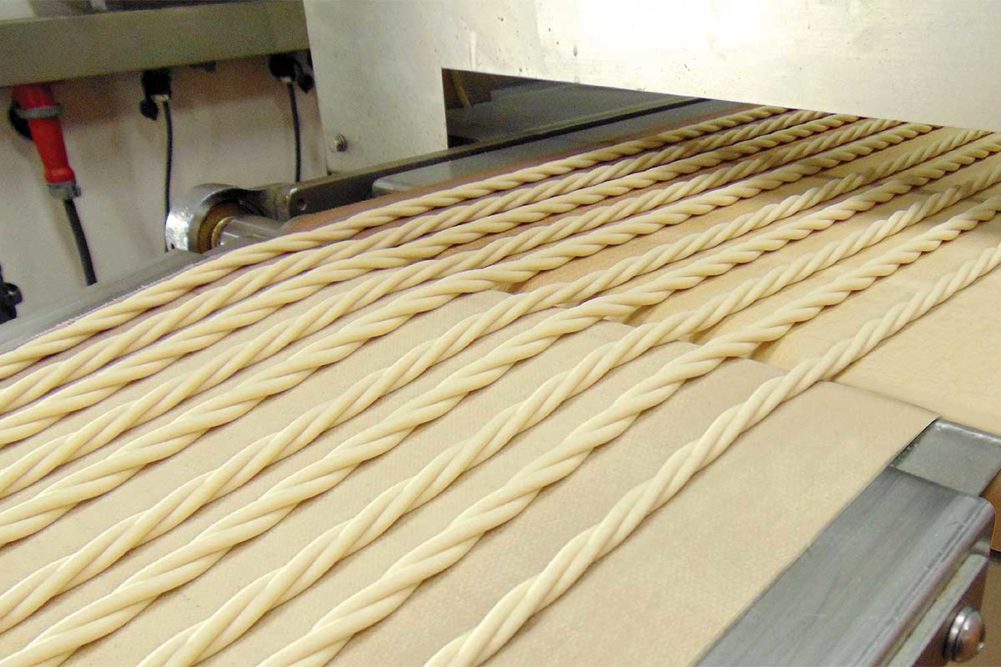Many of today’s innovations, especially grain-free, gluten-free and high-protein snacks, are developed by smaller, artisan-style companies, then co-manufactured by larger operations with plenty of extrusion capacity.
It's a formula that’s served the European market well for years. Now it’s being popularized in America.
“Maybe the United States is following suit with what used to be done in European countries where they launched products in small volumes and test marketed that way rather than going through extensive consumer testing and years of refining before launching a new product,” said Jenni Harrington, director of sales and technology, Bühler.
“It’s more upfront risk taking, but Europeans are more agile and flexible to try something new. Innovation is driven by smaller companies that can afford to take this risk,” she added.
Typically, she noted, twin-screw extruders can handle all types of ingredients while a single-screw system needs larger particle sizes for the intake.
“With twin-screw systems, it’s easy to modify these extruders to get what you need,” she said.
Bruce Campbell, product group leader for Flex, an AMF Bakery Systems brand, pointed out that the number of screws often depends on the product’s variety.
“The main difference is that the dough is generally worked less going through a single screw versus a dual-screw extrusion divider,” he said. “You’ve got the action of the screws turning, agitating the dough a little more, so a single auger theoretically does less of that than a twin auger. That’s why we offer both. We match the type of production that the customer is doing with the style of auger. There’s a lot of overlap, but the twin screws are generally better for the slacker doughs, and the single augers are better for stiffer doughs.”
John Barber, regional sales manager, Clextral USA, suggested twin-screw machines can be configured differently with varying auxiliary equipment making more fun snacks with new shapes or more enticing ones with various flavor combinations.
Clextral’s auto-open extrusion barrel design provides quick access to the screws filled with product and assists with sanitation.
“This allows R&D developers to analyze the extrudate in each barrel segment and make any screw configuration adjustments required,” he said.
In the snacking arena, low-pressure extrusion can typically make bread or pretzel-type snacks as well as other doughs if they can be extruded and hold their shape after forming, suggested Nico Roesler, pretzel and snack equipment sales manager, Reading Bakery Systems (RBS).
Moreover, the system offers versatility because the dies where the dough is extruded can be easily changed.
“One shift, a snack maker can run a standard pretzel shape, the next shift they could run a braided pretzel stick, and the next shift, they could run a filled nugget — all on the same piece of equipment,” he explained. “With this flexibility comes the ability to think of new shapes and concepts to apply to extrusion. Bakers can design custom dies to experiment with the new shapes and sizes of their snacks.”
He added low-pressure extruders use a double-screw configuration, allowing the dough to flow through the extrusion chamber with the appropriate amount of backflow around the screws.
This backflow controls the amount of pressure being generated in the chamber, without impacting dough quality.
“Too much backflow and you sheer the dough and essentially overmix it. Some backflow is necessary to avoid building up too much pressure,” Roesler said.
High-pressure extruders come in a variety of single-, twin- or triple-screw designs. He said RBS offers high-pressure machines with a configurable single screw that can be modified depending on the product being extruded.
Single-screw systems handle potato- and corn-based snacks very well. Alternative ingredients with higher proteins often need additional screws to manage dough flow, avoid blockage and heat the ingredient appropriately through the extrusion process.
Overall, the choice between specialized co-extruders or single-, double- or triple-screw systems plays a crucial role in determining the range and complexity of products, explained Ty Sarajian, president, Axis Automation.
Single-screw options are best suited for less-complex, less-viscous doughs while double-screw extruders offer more control and versatility for handling more complex products and for incorporating delicate ingredients without damaging them.
“Triple-screw extruders further enhance this control, especially beneficial for products requiring precise ingredient mixing and a consistent texture,” Sarajian said.
Specialized co-extruders, he added, enable the production of multi-layered or filled products.
“Using a co-extruder in combination with a third extruder, it’s possible to produce a cookie with vanilla and chocolate doughs — each maintaining its distinct flavor, encasing a chocolate center,” Sarajian observed. “This process requires synchronized extrusion of the doughs side-by-side and precise injection of the filling, showcasing the innovative potential of extruders in creating complex, multi-textural and flavorful products.”
This article is an excerpt from the February 2024 issue of Baking & Snack. To read the entire feature on Extrusion, click here.





